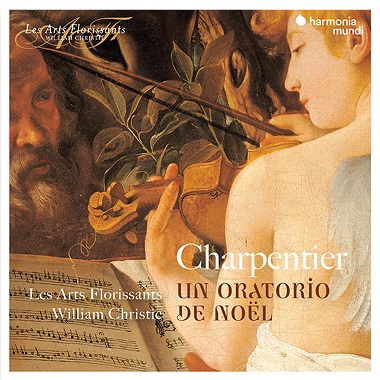Originally issued almost forty years ago, this re-release reminds us of the ease and certainty with which William Christie navigates his way through uncharted French Baroque territory at a time when historically informed performance was still comparatively recent. The disc further reminds us that Nativity texts occupied a particularly important place in the output of Marc-Antoine Charpentier. While his Messe de Minuit is well known, Charpentier has marked the season with other genres, namely Advent ‘O’ Antiphons, instrumental noëls, oratorios and pastorales in the vernacular. No other French composer of this period has demonstrated such a rich and original involvement in the Christmas narrative. Indeed, he set the Latin text In Nativitatem Domini Canticum no fewer than four times. This recorded version of Un Oratorio de Noël (H416) takes centre stage and is flanked by a dozen Antiennes ‘O’ de l’Avent H36-43, four noëls and the pastorale, Sur la Naissance de Notre Seigneur Jesus Christ H482.
Written in the 1690s while he was serving at the Parisian church of Saint Louis, Charpentier’s thirty-minute Un Oratorio de Noël is an engaging work with a pair of choral movements framed by a gentle interlude, ‘La Nuit’. And, what an enchanting effect Christie adds with the inclusion of a tolling bell halfway through its muted string textures. This nocturne provides space for reflection between the anticipation of Christ’s birth, the nativity and subsequent adoration by the shepherds. In the charming Première Partie, solo recitatives and ariosos for tenor and bass voices alternate with animated choruses, while dance-like episodes and festive choruses punctuate extended solo passages for haute contre (sung with great distinction by Dominique Visse) in the joyful ‘Reveil des Bergers’. Charpentier adds more expressive weight to this Deuxième Partie and finds a higher level of inspiration with melting harmonies and expressive silences bearing the influence of Carissimi from the time spent with him in Rome. ‘O infans! O Deus! O salvator noster’ is a particular passage of heightened emotion when the shepherd’s first see the Christ child. Perhaps this glowing performance, will stimulate renewed interest in a composer whose fusion of French sensibility and Italian ardour is so obviously cherished by Christie and his musicians.

Charpentier’s Antiennes ‘O’ de l’Avent, inhabit a more marginal interest. These brief pieces (embracing the mystery of Christ’s coming) are scored for various combinations of vocal and instrumental groups and are interleaved by instrumental Noëls with a folk like character. Significantly, they indicate the musical resources available to the composer during his tenure as maître de musique in Paris, and are a sure sign of their elevated stratus within the liturgy. Performed before and after the Magnificat at Vespers on each of the seven days preceding Christmas, these ‘O’ antiphons would have originally been sung with great reverence and as a cappella plainchant. The booklet note writer comments of the expressive devices Charpentier employs to illustrate the texts, claiming ‘the overall tone of these antiphons remains sober’. Yet, these performances are rendered in a strong affirmative manner, such that the delicate theorbo in (for example) ‘O Adonai’ is nearly overwhelmed. Things improve with the richer vocal textures of ‘O Clavis‘, and in the marvellous vocal and string writing of ‘O Oriens’. Overall, these antiphons are rendered with enthusiasm, and illustrate a valuable facet of Charpentier’s oeuvre.
A decade before these works Charpentier conceived his Sur la Naissance de Notre Seigneur Jesus Christ (1684), a pastorale that would presumably have been written for performance at court or within the household of his patron the Duchess Marie de Lorraine – Mademoiselle de Guise. To its folk-inspired sensibility, Les Arts Florissants respond with nimble playing (recorders are captured well in dance passages) and choral singing of rhythmic buoyancy. The distinctive timbre of Dominique Visse, as the shepherd Tircis, provides sharp contrast to the understated elegance of Agnès Melon’s Silvie.
In summary, this is seasonal music as its most charming, and with performances as wholly idiomatic as this, this CD is well worth exploring. Just a pity the booklet texts are only in Latin and French.
David Truslove
Antiennes ‘O’ de l’Avent H36-43, Noëls pour les instruments H534, Un Oratorio de Noël: In Nativitatem Domini Canticum H416, Sur la Naissance de Notre Seigneur Jesus Christ H482.
Les Arts Florissants, William Christie (director).
harmonia mundi HAF8905130 [74:57]